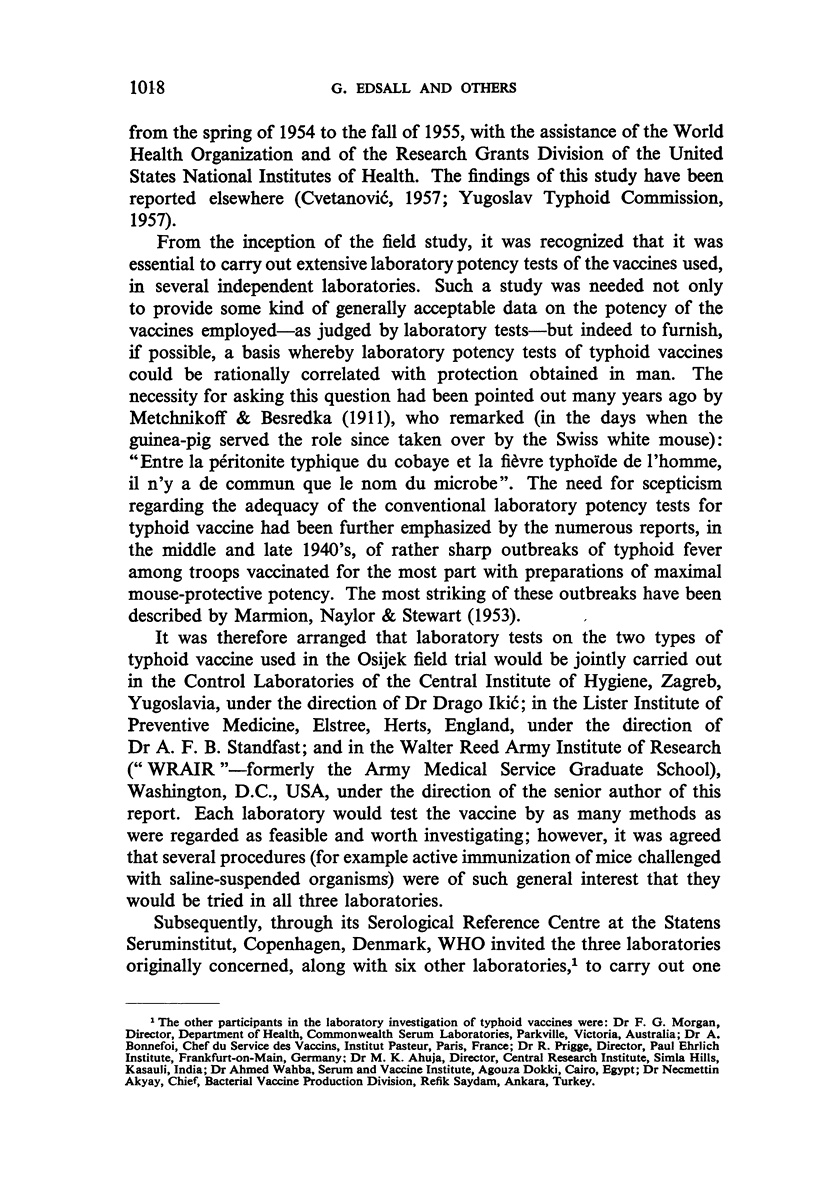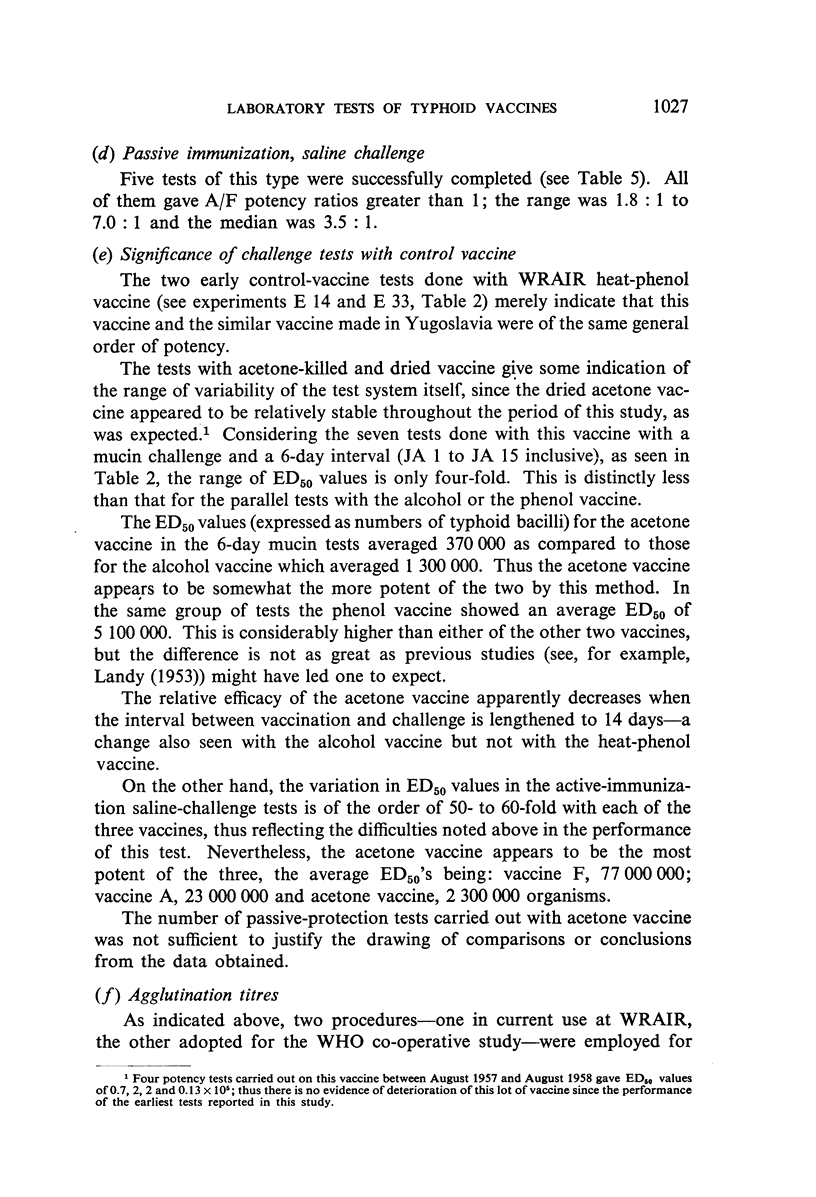Abstract
In 1954-55, a controlled field trial of two types of typhoid vaccine—alcoholized (“vaccine A”) and phenolized (“vaccine F”)—prepared in Yugoslavia was carried out in the town and district of Osijek. In an attempt to correlate the protection conferred on man by these vaccines with their potency in laboratory animals, arrangements were made for laboratory tests to be performed jointly by the Central Institute of Hygiene, Zagreb, Yugoslavia; the Lister Institute of Preventive Medicine, Elstree, Herts, England; and the Walter Reed Army Institute of Research (WRAIR), Washington, D.C., USA. In this paper, the results of the WRAIR tests are presented.
The potency relationship between vaccine A and vaccine F was found to vary with the type of test performed. According to active-immunization tests in mice, using either mucin or saline challenge, vaccine A was more potent than vaccine F, as it proved also in the passive immunization of mice with saline challenge and in Vi-antibody production in rabbits. As judged by the results of the passive immunization of mice with mucin challenge and of O-antibody production in rabbits, there was, however, no clear-cut difference in potency between the two vaccines. And, as indicated by H-antibody production in rabbits, vaccine F was clearly superior to vaccine A. Since vaccine F was also the more effective in man, the last-mentioned findings are of considerable interest, suggesting that the H antigen may be more, and the Vi antigen less, important in protecting man against typhoid fever than is currently considered to be the case.
Full text
PDF















Selected References
These references are in PubMed. This may not be the complete list of references from this article.
- CVJETANOVIC B. B. Field trial of typhoid vaccines. Am J Public Health Nations Health. 1957 May;47(5):578–581. doi: 10.2105/ajph.47.5.578. [DOI] [PMC free article] [PubMed] [Google Scholar]
- LANDY M. Enhancement of the immunogenicity of typhoid vaccine by retention of the V1 antigen. Am J Hyg. 1953 Sep;58(2):148–164. doi: 10.1093/oxfordjournals.aje.a119596. [DOI] [PubMed] [Google Scholar]
- LANDY M., GAINES S., SEAL J. R., WHITSIDE J. E. Antibody responses of man to three types of antityphoid immunizing agents: heat-phenol fluid vaccine, acetone-dehydrated vaccine, and isolated Vi and O antigens. Am J Public Health Nations Health. 1954 Dec;44(12):1572–1579. doi: 10.2105/ajph.44.12.1572. [DOI] [PMC free article] [PubMed] [Google Scholar]
- LANDY M., LAMB E. Estimation of Vi antibody employing erythrocytes treated with purified Vi antigen. Proc Soc Exp Biol Med. 1953 Apr;82(4):593–598. doi: 10.3181/00379727-82-20188. [DOI] [PubMed] [Google Scholar]
- LANDY M., PILLEMER L. Increased resistance to infection and accompanying alteration in properidin levels following administration of bacterial lipopolysaccharides. J Exp Med. 1956 Sep 1;104(3):383–409. doi: 10.1084/jem.104.3.383. [DOI] [PMC free article] [PubMed] [Google Scholar]
- MARMION D. E., NAYLOR G. R., STEWART I. O. Second attacks of typhoid fever. J Hyg (Lond) 1953 Jun;51(2):260–267. doi: 10.1017/s0022172400015680. [DOI] [PMC free article] [PubMed] [Google Scholar]
- ROWLEY D. Stimulation of natural immunity to Escherichia coli infection: observations on mice. Lancet. 1955 Jan 29;268(6857):232–234. doi: 10.1016/s0140-6736(55)90163-x. [DOI] [PubMed] [Google Scholar]
- SPAUN J. Biological standardization of typhoid vaccines by antibody measurements. Acta Pathol Microbiol Scand. 1956;39(6):469–480. doi: 10.1111/j.1699-0463.1956.tb05074.x. [DOI] [PubMed] [Google Scholar]


